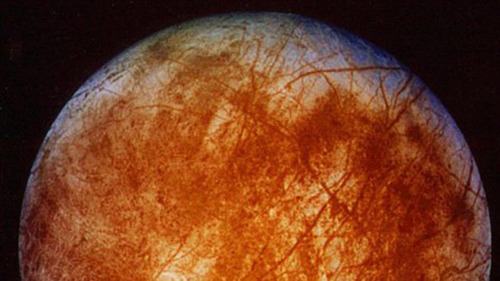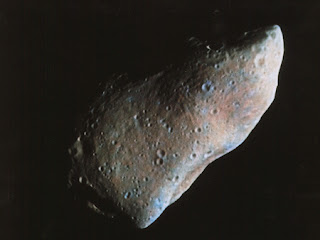Astronomy Love!
Saturday, 24 March 2012
Tuesday, 6 March 2012
Life near Jupiter? Moon's oceans too acidic, scientists say

Jupiter's moon Europa is thought to have a metallic core surrounded by a rocky interior, and then a global ocean on top of that, surrounded by a shell of water ice.
The ocean underneath the icy shell of Jupiter's moon Europa might be too acidic to support life, due to compounds that may regularly migrate downward from its surface, researchers say.
Scientists believe that Europa, which is roughly the size of Earth's moon, possesses an ocean perhaps 100 miles deep (160 kilometers). This ocean is overlain by an icy crust of unknown thickness, although some estimates are that it could be only a few miles thick.
Since there is life virtually wherever there is liquid water on Earth, for many years scientists have entertained the notion that this Jovian moon could support extraterrestrials. Recent findings even suggest its ocean could be loaded with oxygen, enough to support millions of tons worth of marine life like the kinds that exist on Earth.
However, chemicals found on the surface of Europa might jeopardize any chances of life evolving there, scientists find. The resulting level of acidity in its ocean "is probably not friendly to life — it ends up messing with things like membrane development, and it could be hard building the large-scale organic polymers," said Matthew Pasek, an astrobiologist at the University of South Florida.
Destructive chemicals
The compounds in question are oxidants, which are capable of receiving electrons from other compounds. These are usually rare in the solar system because of the abundance of chemicals known as reductants such as hydrogen and carbon, which react quickly with oxidants to form oxides such as water and carbon dioxide.
Europa happens to be rich in strong oxidants such as oxygen and hydrogen peroxide, which are created by the irradiation of its icy crust by high-energy particles from Jupiter.
The oxidants on Europa's surface are likely carried downward in potentially substantial quantities by the same churning that causes water to rise from below. Oxidants could be of great use to any life in Europa's ocean — for example, oxygen was pivotal to how complex life evolved on Earth.
However, oxidants from Europa's surface might react with sulfides and other compounds in its ocean before life could nab it, generating sulfuric and other acids, investigators said. If this has occurred for just about half of Europa's lifetime, not only would such a process rob the ocean of life-supporting oxidants, but it could become relatively corrosive, with a pH of about 2.6 — "about the same as your average soft drink," Pasek said.
This level of acidity would be a significant challenge for life, unless organisms were to consume or sequester oxidants fast enough to ameliorate the acidification, researchers said. The ecosystem would need to evolve quickly to meet this crisis, with oxygen metabolisms and acid tolerance developing in only about 50 million years to handle the acidification.
Thursday, 16 February 2012
Why Are Planets Sphere?
Stars are perfect examples of natural spheres. the mass of a star is mind-boggling, large and creates and equally mind-boggling large amount of gravity. What shape does Mother Nature give to so much mass to minimize its enormous value? A sphere.
The reason planets appear so spherical is because gravity compresses the planet into a shape that most evenly distributes the gravitational force among the planet's mass.
Whether it is shaping water droplets, stars, soap bubbles or planets, nature seeks to minimize the surface area needed to contain a given volume, and the shape that keeps volume at the absolute minimum a sphere.
Any object in weightless space larger than a couple of hundred miles in diameter has enough mass for its gravity to overcome large-scale irregularities and force it into a spherical shape. The gravitational compression also generates significant amounts of heat at the center of the planet. This heat melts, or at least soften, any solid materials within the planet, facilitating the planet's collapse into a sphere.
Objects in space smaller than about 100 miles in diameter, such as most asteroids, comet nuclei, and small moons, lack the mass to create a gravtational field strength strong enough to compress themselves into spheres. These little spheres are often taken on what I call the 'sick potato' look.
A really large asteriod, such as Ceres (diameter = 600 miles), has enough mass for its gravity to compress it into a sphere.
However, 'perfect' spheres are hard to find in space.
 |
| (Stars like our Sun are huge, dynamic, energy-producing concentrations of Hydrogen and Helium, compacted by their enormous gravity into spheres.) |
Whether it is shaping water droplets, stars, soap bubbles or planets, nature seeks to minimize the surface area needed to contain a given volume, and the shape that keeps volume at the absolute minimum a sphere.
Any object in weightless space larger than a couple of hundred miles in diameter has enough mass for its gravity to overcome large-scale irregularities and force it into a spherical shape. The gravitational compression also generates significant amounts of heat at the center of the planet. This heat melts, or at least soften, any solid materials within the planet, facilitating the planet's collapse into a sphere.
Objects in space smaller than about 100 miles in diameter, such as most asteroids, comet nuclei, and small moons, lack the mass to create a gravtational field strength strong enough to compress themselves into spheres. These little spheres are often taken on what I call the 'sick potato' look.
 |
| (The 12.5 miles long, 7.5 mile wide asteroid Gaspra, imaged October 1991 from a distance of 1600 miles by the Galelio spacecraft en route to Jupiter) |
 |
| (The 600 mile-wide asteroid Ceres as seen by the Hubble Space Telescope) |
Pretty much everything in space rotates, and a rotating non-rigid sphere causes it to 'bulge' at its equator from the centrifugal forces acting on it.
This spinning distorted large planets into a slightly squashed shape known as an 'oblate spheroid'. This means that a planet's diameter measured through its poles is smaller than the diameter measured through its equator.
Whereas the difference between the polar diameter and the equatorial diameter of Earth is a barely noticeable 0.3%, the oblateness of Saturn, a large, gaseous and rapidly spinning planet, is greater than 10%. You can easily see Saturn's polar flattening through a telescope.
 |
| (Saturn's polar diameter is 33,700 miles, but its equatorial diameter is 37,360 miles) |
Saturday, 4 February 2012
Is The Earth Getting Smaller?
There are factors that are causing Earth to both gain and lose mass over time, according to Dr Chris Smith, a medical microbiologist and broadcaster who tries to improve the public understanding of science.
Using some back-of-the-envelope-style calculations, Dr Smith, with help from physicist and Cambridge University colleague Dave Ansell, drew up a balance sheet of what’s coming in, and what’s going out. All figures are estimated.
By far the biggest contributor to the world’s mass is the 40,000 tonnes of dust that is falling from space to Earth, says Dr Smith.
“[The dust] is basically the vestiges of the solar system that spawned us, either asteroids that broke up or things that never formed into a planet, and it’s drifting around.
“The Earth is acting like a giant vacuum cleaner powered by gravity in space, pulling in particles of dust,” says Dr Smith.
Another much less significant reason the planet is gaining mass is because of global warming.
“Nasa has calculated that the Earth is gaining about 160 tonnes a year because the temperature of the Earth is going up. If we are adding energy to the system, the mass must go up,” says Dr Smith.
This means that in total between 40,000 and 41,000 tonnes is being added to the mass of the planet each year.
Population growth and new buildings are not a factor, he says, because both of these are actually made up of existing matter on the planet.
But overall, Dr Smith has calculated that the Earth - including the sea and the atmosphere - is losing mass. He points to a handful of reasons.
For instance, the Earth’s core is like a giant nuclear reactor that is gradually losing energy over time, and that loss in energy translates into a loss of mass.
But this is a tiny amount - he estimates no more than 16 tonnes a year.
And what about launching rockets and satellites into space, like Phobos-Grunt? Dr Smith discounts this as most of it will fall back down to Earth again.
But there is something else that is making the planet lose mass. Gases such as hydrogen are so light, they are escaping from the atmosphere.
“Physicists have shown that the Earth is losing about three kilograms of hydrogen gas every second. It’s about 95,000 tonnes of hydrogen that the planet is losing every year.
“The other very light gas this is happening to is helium and there is much less of that around, so it’s about 1,600 tonnes a year of helium that we lose.”
So taking into account the gains and the losses, Dr Smith reckons the Earth is getting about 50,000 tonnes lighter a year, which is just less than half the gross weight of the Costa Concordia, the Italian cruise liner, that ran aground recently.
Summary:
- It’s getting lighter, by about 50,000 tonnes in mass each year, but not due to space dust
- Some factors include:
- Gains: Mostly dust (like an asteroid, above) falling from space, plus increased energy from increases in the planet’s temperature
- Losses: Mostly hydrogen, plus some helium and a tiny amount of lost energy
Sunday, 29 January 2012
The Carina Nebula: Star Birth in the Extreme
This image, released for Hubble Space Telescope's 17th anniversary, shows a region of star birth and death in the Carina Nebula. The nebula contains at least a dozen brilliant stars that are 50 to 100 times the mass of our Sun.
Download Full Resolution Images:
JPEG | 200.06 MB | 29566x14321px
http://imgsrc.hubblesite.org/hu/db/images/hs-2007-16-a-full_jpg.jpg
TIFF | 479.08 MB | 29566x14321px
http://imgsrc.hubblesite.org/hu/db/images/hs-2007-16-a-full_tif.tif
Credit: NASA, ESA, N. Smith (University of California, Berkeley), and The Hubble Heritage Team (STScI/AURA)
Download Full Resolution Images:
JPEG | 200.06 MB | 29566x14321px
http://imgsrc.hubblesite.org/hu/db/images/hs-2007-16-a-full_jpg.jpg
TIFF | 479.08 MB | 29566x14321px
http://imgsrc.hubblesite.org/hu/db/images/hs-2007-16-a-full_tif.tif
Credit: NASA, ESA, N. Smith (University of California, Berkeley), and The Hubble Heritage Team (STScI/AURA)
Thursday, 26 January 2012
Auroras In The Night Sky Over Norway
January 22, 2012
Aurora over Tromvik, Troms Fylke, Norway
January 24, 2012
Aurora over Tromso, northern Norway
Astrophoto: Purple Orion
This beautiful photo of the Orion Nebula was taken by Marco T. in Italy on January 25, 2012. It was taken with a Canon 500d, and a Skywatcher Black Diamond ED80 Pro
“Sum of 32 shots of 85 seconds at 800 iso and 10 darks,” Marco says. “From Rome so light pollution is high as always, temperature 2 degrees.”
Subscribe to:
Posts (Atom)





